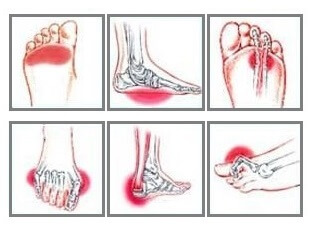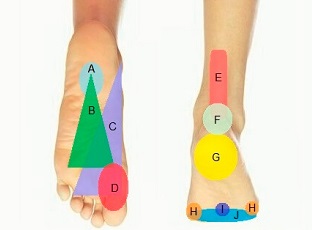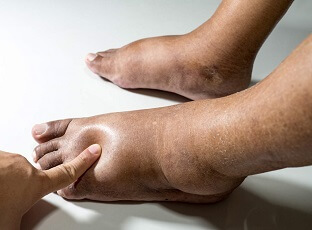- Home
- Common Foot Problems
- Foot Rashes
- Athlete's Foot
Tinea Pedis: Athlete's Foot
Written By: Chloe Wilson BSc(Hons) Physiotherapy
Reviewed By: FPE Medical Review Board
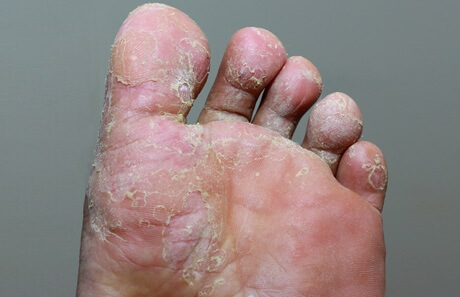
Tinea pedis, commonly known as Athlete’s Foot, is a common fungal infection that usually starts between the toes.
It causes an itchy, scaly foot rash on infected skin that may be reddish or white in colour.
Athlete’s foot is highly contagious and is easily spread via towels, clothing or contaminated floors. It thrives in warm, damp environments and can cause significant discomfort.
In this article, we’ll explore what athlete’s foot is, common ringworm symptoms, causes and treatment options, as well as our top tips for preventing tinea pedis.
What is Athlete’s Foot?
Athlete’s foot, aka tinea pedis or ringworm on foot, is a contagious fungal infection that affects the skin on the feet. It is caused by dermatophytes, a type of fungus that feeds on keratin, a protein found in the skin, hair, and nails.
The ringworm fungus can enter the foot through tiny wounds or cracks in the skin and infects the top layer. Athlete’s foot typically begins between the toes and can spread to other parts of the foot or body if untreated. Despite its name it can affect anyone, not just athletes.
The term “ringworm” refers to the circular, red patches often seen in fungal infections, though no actual worm is involved. It is the most common cause of a foot rash.
How Common is Athlete’s Foot?
Athlete’s foot is the most common fungal infection. Estimates suggest that 5% to 25% of the population has tinea pedis at any given time, and up to 70% of people will experience it at some point in their lives.
Athlete’s Foot Symptoms
Foot ringworm symptoms can vary from mild to severe, depending on the extent of the infection. Common tinea pedis symptoms include:
- Itchy, Scaly Skin: Persistent itching, particularly between the toes, is a hallmark symptom of tinea pedis. There may be a circular ringworm rash
- Redness and Inflammation: The affected area may appear red, swollen, or inflamed.
- Cracked or Peeling Skin: The skin may become dry and start to peel or crack, especially between the toes or on the soles.
- Blisters: In some cases, small fluid-filled blisters may form, causing pain or discomfort.
- Burning or Stinging Sensation: Some people experience a sensation of burning or stinging in the infected area.
- Thickened White Skin: Chronic infections can lead to thickened, callus-like skin that is whitish in colour.
The most common place to get ringworm on the foot is between the little toe and the fourth toe. Athlete’s foot symptoms typically appear 4-14 days after exposure to the fungus.
If left untreated, the infection can spread to the nail, causing a fungal nail infection, or other areas of skin, particularly the hands. Athlete's foot is often mistaken for foot eczema.
Causes of Tinea Pedis
Athlete’s foot is caused by dermatophyte fungi, which thrive in warm, moist environments. Tinea pedis is highly contagious and easily spread by contact. Common causes include:
- Sweaty Feet: Excessive moisture creates the perfect breeding ground for ringworm fungi
- Tight, Non-Breathable Shoes: Shoes that don’t allow proper ventilation can trap moisture, providing the perfect breeding ground for the fungus, increasing the risk of infection.
- Walking Barefoot in Public Areas: Public showers, swimming pools, and locker rooms are hotspots for fungal infections.
- Sharing Personal Items: Using someone else’s shoes, socks, or towels can spread the fungus.
- Weakened Immune System: A compromised immune system may make you more susceptible to ringworm fungal infections.
Risk Factors
Athlete’s foot can affect anyone, but certain groups are more susceptible. You may be at higher risk if you have:
- Diabetes: High blood sugar levels can weaken the immune system and make the skin more prone to infections. Diabetes can also cause nerve damage and reduced blood flow to the legs making the skin more prone to small cuts and abrasions that often go unnoticed
- Obesity: Increased sweating and skin folds create ideal conditions for fungi to thrive
- Gender: women are less likely to get tinea pedis than men
- Weakened Immune System: Medical conditions or treatments that suppress immunity increase susceptibility to ringworm on foot
- Tissue Damage or Wounds on Your Feet: Open cuts or sores make it easier for fungi to enter and infect the skin.
- Genetics: some people have a genetic predisposition to tinea pedis. If lots of your family have had athlete’s foot, you are at higher risk
- Circulation Problems: in the legs and feet e.g. peripheral artery disease or ischaemia increase the risk of tinea pedis
Tinea Pedis Diagnosis
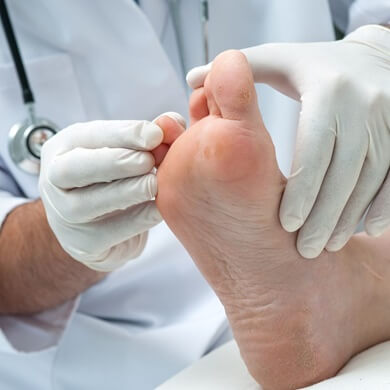
A healthcare professional can diagnose tinea pedis by asking you about your symptoms and hobbies and carrying out a physical exam of the affected area for tell-tale signs like redness, scaling, and peeling.
In some cases, your doctor may take a small sample of the affected skin, known as skin scraping, for microscopic examination or fungal culture to confirm the presence of dermatophytes.
When to See a Doctor
While most cases of ringworm infection on the foot respond well to over-the-counter treatments and self-care, you will need to see your doctor if:
- The infection is not improving after two weeks of treatment.
- You experience severe redness, swelling, or pain, which may indicate a secondary bacterial infection.
- The infection spreads to other parts of the body, such as the toenails or hands.
- You have diabetes, a weakened immune system, or other health conditions that increase the risk of complications.
Seeking timely medical advice ensures proper ringworm treatment and prevents the athlete’s foot from worsening or spreading to others.
Athlete’s Foot Treatment
Athlete’s foot doesn’t usually improve on its own, but it does typically respond very well to simple tinea pedis treatments. Prompt ringworm on foot treatment can help alleviate symptoms and prevent the infection from spreading. Effective athlete’s foot treatment includes:
1. Over-the-Counter Antifungal Medications
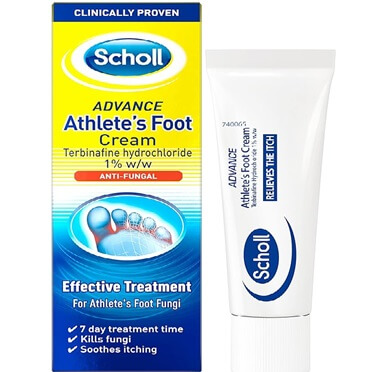
Topical creams, sprays, or powders containing ingredients like terbinafine or clotrimazole are effective tinea pedis treatments in most cases.
These are typically available without a prescription and are readily available from a pharmacy or Amazon.
You should continue to use anti-fungals for two weeks after the symptoms have gone to prevent recurrence of ringworm on foot.
Always wash your hands after applying treatment to prevent spread.
2. Prescription Medications
For severe or persistent infections, a doctor may prescribe stronger antifungal creams or oral tinea pedis medications containing active ingredients such as itraconazole or terbinafine.
3. Hygiene Practices
Good hygiene is really important with tinea pedis to stop the progression and spread of athlete's foot:
- Keep your feet clean and dry at all times
- Wash your feet daily with soap and water, ensuring you dry thoroughly between the toes with a clean towel
- Wash your towels and bedding at 60 degrees
4. Footwear Tips
Opt for breathable shoes and moisture-wicking socks made of natural fibres e.g. cotton, to reduce sweating.
Avoid wearing the same shoes every day; allow them to air out. Ideally don’t wear the same pair of shoes for more than one day at a time.
5. Home Remedies
Some people find relief from foot ringworm using natural remedies like tea tree oil, which has antifungal properties. However, these should be used with caution and as a complement to medical treatments.
If you have athlete’s foot, don’t be tempted to apply moisturiser between your toes, even if the skin is dry and itchy, as this just makes it easier for the fungus to thrive.
Prevention
Preventing athlete’s foot is key to avoiding the discomfort, inconvenience and recurrence of this fungal infection. Here are some tips to help reduce your risk of developing tinea pedis:
- Maintain Good Foot Hygiene: Wash your feet daily with soap and water, and make sure to dry thoroughly, especially between the toes.
- Wear Breathable Footwear: Choose shoes made of materials that allow airflow and avoid overly tight footwear. Allow your shoes to air out between uses, and use antifungal sprays or powders in them if needed. Change shoes daily, giving them a chance to fully dry out.
- Wear Breathable Socks: Opt for moisture-wicking socks that draw moisture away from the skin and change them if they become damp.
- Protect Your Feet in Public Areas: Always wear flip-flops or sandals in communal showers, locker rooms, and pool areas.
- Avoid Sharing Personal Items: Do not share shoes, socks, or towels with others.
- Trim Toenails Properly: Keep your toenails clean and short to prevent fungal build-up.
By following these preventive measures, you can significantly reduce your chances of developing athlete’s foot.
Tinea Pedis Summary
Tinea pedis, aka ringworm on foot or athlete’s foot, is a common and contagious fungal infection that can cause discomfort if left untreated.
Recognizing the symptoms early and addressing the condition with antifungal treatments and good hygiene practices is key to a quick recovery. Ringworm on foot causes dry, scaly skin and a white or red foot rash. It is often mis-diagnosed as foot eczema
By keeping your feet clean, dry, and protected in public areas, you can significantly reduce the risk of ringworm infection. If tinea pedis symptoms persist or worsen, consult a healthcare professional for further evaluation and treatment.
You may be interested in the following articles:
Related Articles
References
- Athlete's Foot Overview. Guys' & St Thomas' NHS Foundation Trust
- Athlete's Foot. British Medical Journal Clinical Evidence
- Overview: Athlete's Foot. Informed Health
Page Last Updated: 22nd January, 2025
Next Review Due: 22nd January, 2027
